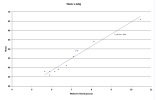When it gets close to my annual Hba1c I use different testing methods to give me some idea what the result might be. I am aware Hba1c is the gold standard and my chosen guesstimators won't be the exact result. I use accu check and check the 90.day average and I also use mysugr app.
Accucheck.has 6.1 average and mysugr gave me 5.8 (34.7).
Probably not the best use of my time but... which is the more reliable one?
Accucheck.has 6.1 average and mysugr gave me 5.8 (34.7).
Probably not the best use of my time but... which is the more reliable one?


